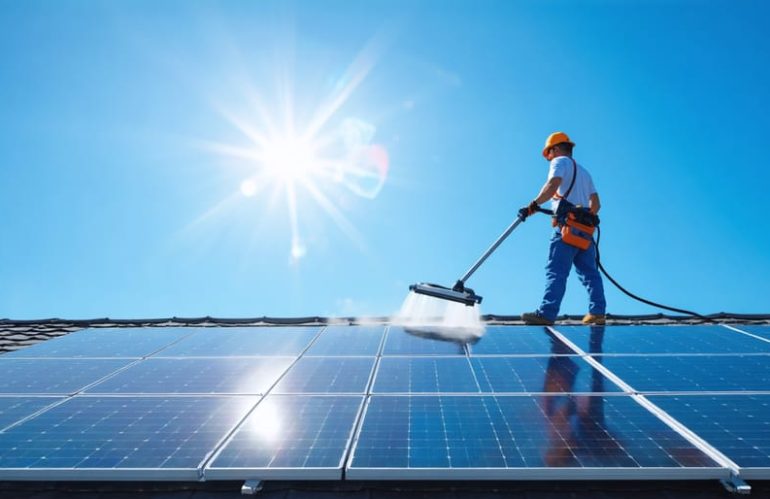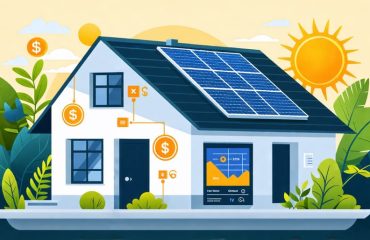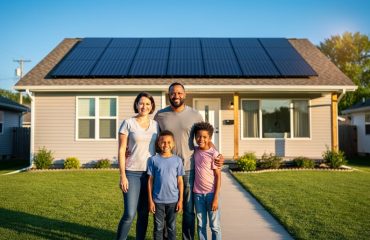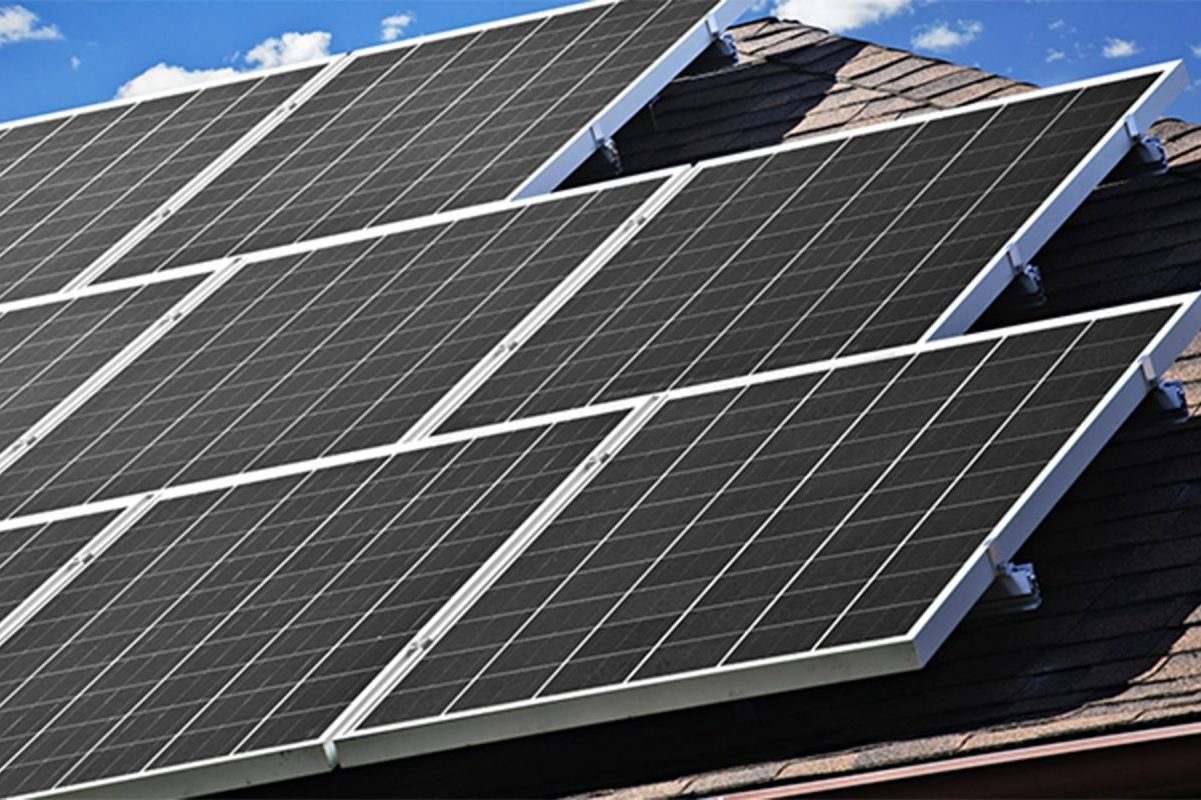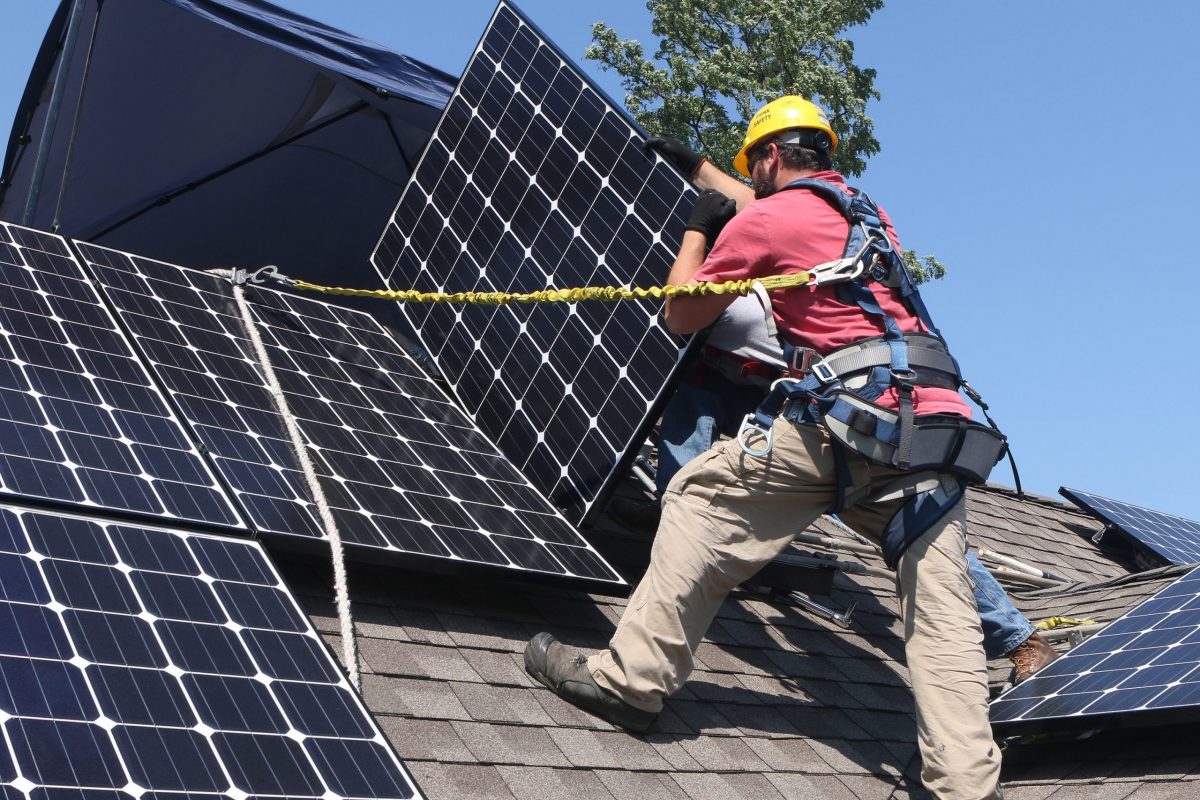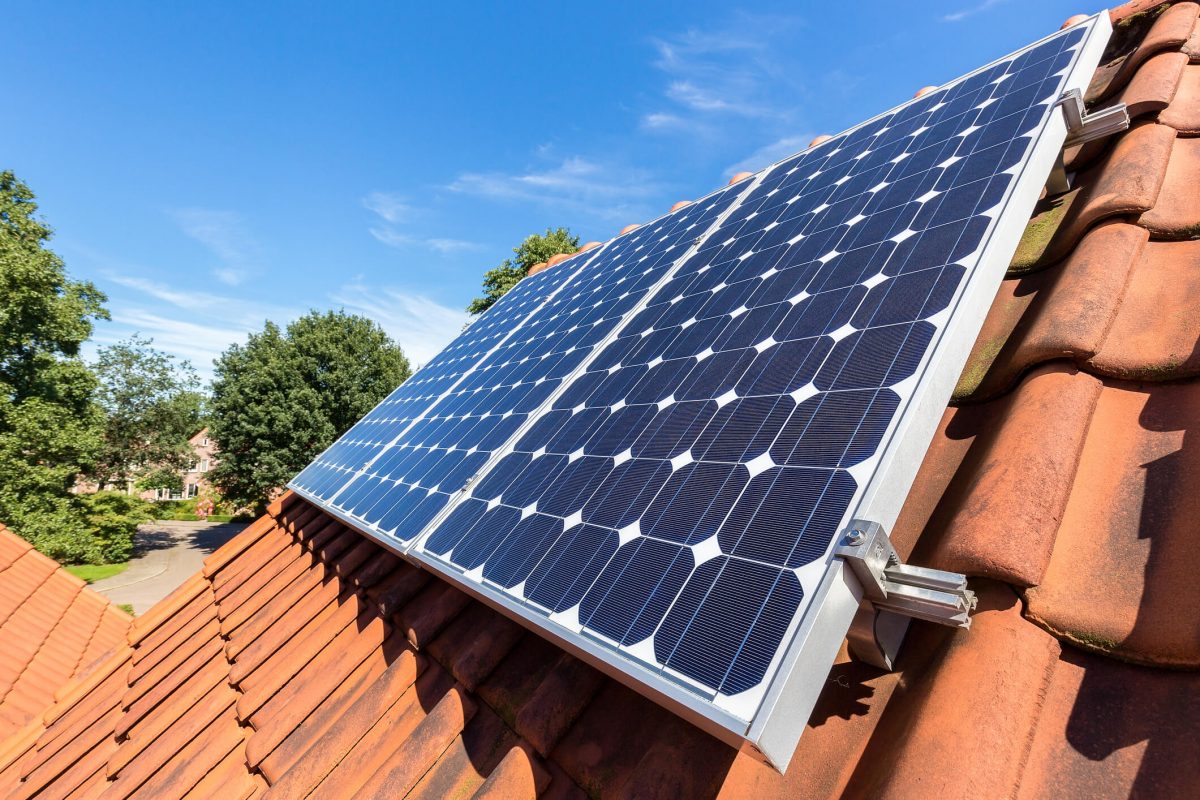Keep your solar panels performing at peak efficiency without ever climbing a ladder. The impact of dirty solar panels can reduce energy production by up to 25%, but ground-level cleaning offers a safe, effective solution. Using an extendable water-fed pole with soft bristles, deionized water, and specialized solar panel cleaning attachments, you can maintain your investment while keeping both feet firmly on the ground. Modern telescopic equipment reaches panels up to 24 feet high, making professional-quality cleaning accessible to every homeowner. Regular maintenance from ground level not only maximizes energy production but also helps identify potential issues early, extending the life of your solar investment while ensuring optimal performance year-round.
Why Ground-Level Solar Panel Cleaning Matters
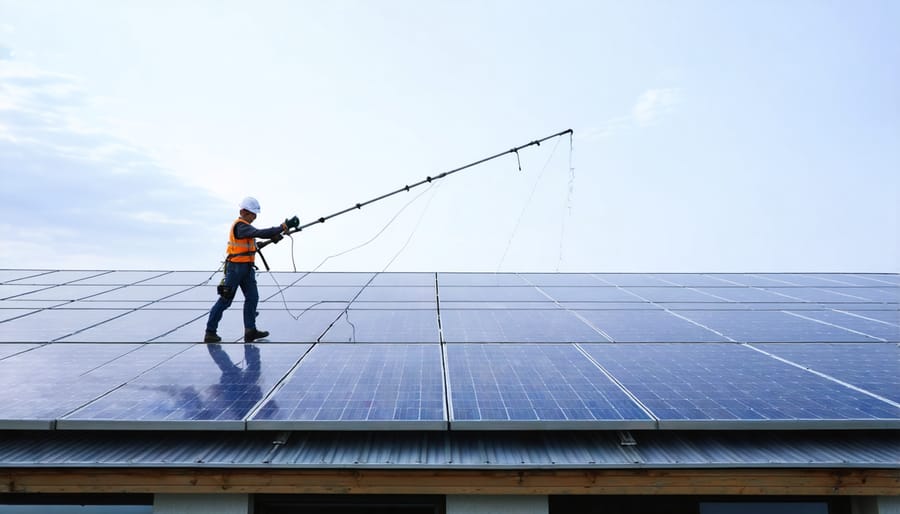
Safety First: Avoiding Roof Accidents
Maintaining solar panels shouldn’t put your safety at risk. Roof accidents are among the most common home maintenance injuries, with falls accounting for thousands of emergency room visits each year. Working on a sloped surface, especially when wet from cleaning, dramatically increases the risk of slipping. Add to this the awkward positioning needed to clean panels and the weight of cleaning equipment, and you’ve got a recipe for potential disaster.
Ground-level cleaning eliminates these dangers entirely. By keeping your feet firmly planted on solid ground, you maintain better balance and control while cleaning. You’ll also avoid the risks associated with carrying heavy equipment up and down ladders or navigating around roof obstacles. This approach is particularly important during adverse weather conditions or for homeowners with physical limitations.
Remember, even professional solar panel cleaners prioritize safety by using specialized equipment designed for ground-level maintenance whenever possible. Your solar investment is important, but your personal safety is priceless.
Maintaining Panel Efficiency Without Ladders
Regular ground cleaning of your solar panels can maintain up to 95% of their optimal performance when done correctly. While roof-mounted cleaning might seem more thorough, ground-level maintenance using the right tools can be equally effective. The key is consistency – cleaning your panels every three to four months prevents the heavy buildup that typically requires more intensive cleaning methods.
Using an extension pole with a soft brush attachment and pure water can remove most dust, pollen, and bird droppings that affect panel efficiency. This approach, combined with automated monitoring of your system’s output, helps you identify when cleaning is necessary. Many homeowners report maintaining peak performance by establishing a simple quarterly cleaning routine from ground level.
Remember that even a light coating of dirt can reduce efficiency by 5-10%, so regular ground cleaning is a practical way to protect your investment and maintain optimal energy production without risking roof access.

Essential Tools for Ground-Level Panel Cleaning
Telescopic Cleaning Poles
Telescopic cleaning poles are essential tools for safely maintaining your solar panels from ground level. These adjustable poles typically extend from 12 to 30 feet, making them suitable for most residential installations. Look for poles made from lightweight yet durable materials like aluminum or carbon fiber, which provide the perfect balance of strength and maneuverability.
Many quality poles feature quick-lock mechanisms that secure each section firmly in place, preventing unwanted collapse during use. Some models come with ergonomic grips and non-slip handles, making them comfortable to use for extended cleaning sessions. For added versatility, choose poles with universal threading that accommodates different cleaning attachments.
When selecting a telescopic pole, consider features like water flow-through capability, which allows you to connect a garden hose directly to the pole for more efficient cleaning. Advanced models may include angle adjusters that help you reach tricky spots and corners. Remember to check the weight capacity and fully extended length to ensure the pole meets your specific needs.
For optimal results, pair your telescopic pole with appropriate cleaning attachments designed specifically for solar panels, such as soft-bristled brushes or microfiber heads.
Specialized Cleaning Attachments
Modern specialized cleaning attachments make maintaining your solar panels from ground level both effective and convenient. The most essential tool is a microfiber brush head, designed specifically for solar panels with soft bristles that won’t scratch the delicate surface while removing dust and debris. These brush heads typically feature curved edges to match the panel’s surface area for maximum cleaning efficiency.
Water-fed extension poles often come with interchangeable attachments, including squeegees with rubber blades that help remove water without leaving streaks. Some advanced models feature dual-action heads combining both brush and squeegee functions, allowing you to clean and dry in one smooth motion.
For stubborn dirt, specialized solar panel cleaning solutions can be applied using foam cannon attachments that create a thick cleaning foam that clings to the panels even when working from below. Corner cleaning brushes with angled heads help reach tricky spots where dirt tends to accumulate.
Many manufacturers now offer all-in-one cleaning kits that include multiple attachments designed to work together, ensuring you have the right tool for every cleaning challenge while maintaining safe ground-level access.
Step-by-Step Ground Cleaning Process
Preparation Steps
Choose a cloudy day or early morning for cleaning to prevent water from evaporating too quickly and leaving residue. Avoid cleaning during peak sunlight hours when panels are hot, as rapid temperature changes could damage them. Before starting, inspect your panels from the ground using binoculars to identify particularly dirty areas and potential challenges.
Gather your cleaning supplies: a soft-bristled brush with an extendable pole, a water hose with adjustable nozzle, and mild soap if needed. Ensure your hose can reach all panels comfortably from the ground. Clear the surrounding area of any obstacles that might restrict your movement or create tripping hazards.
Test your water pressure on a small section first – it should be strong enough to clean but gentle enough to prevent damage. If using an extension pole, practice your technique on a lower section to get comfortable with the tool’s reach and movement before tackling higher areas.
Cleaning Technique
Start by diluting your eco-friendly solar panel cleaning solution according to the manufacturer’s instructions in a bucket of deionized water. Using your extension pole with a soft brush attachment, gently apply the solution to the panels in smooth, horizontal strokes. Follow proper cleaning techniques by working from the bottom up to prevent dirty water from running down over already cleaned areas.
Avoid applying excessive pressure, which could scratch the panels’ surface. Instead, let the cleaning solution do the work of breaking down dirt and grime. After applying the solution, use clean water and a squeegee attachment to rinse thoroughly, ensuring no cleaning residue remains. For stubborn spots, repeat the process rather than scrubbing aggressively.
Work during early morning or evening hours when panels are cool to prevent rapid evaporation of cleaning solution and water spots. If you notice any particularly resistant debris or staining, make note of its location and consult with a professional rather than attempting aggressive cleaning methods that might damage your panels.
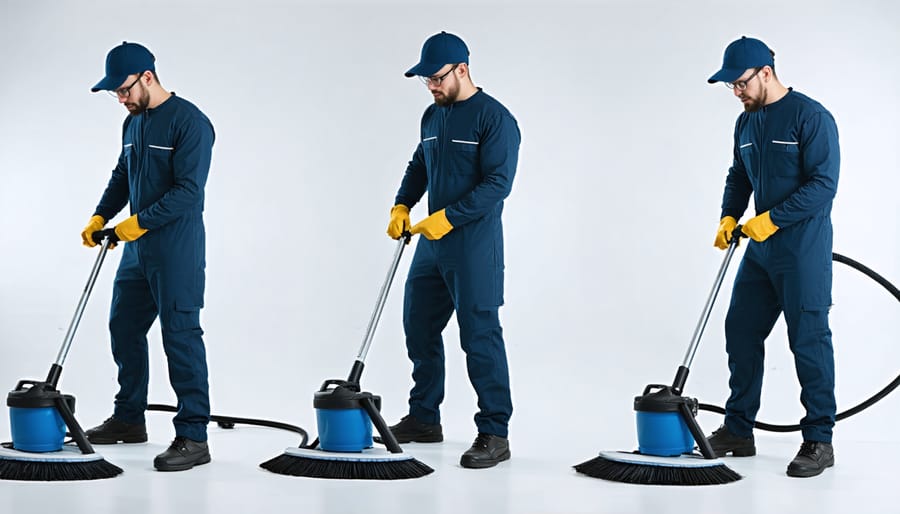
Final Touches
After cleaning, take a few moments to inspect your work from different angles. The panels should appear uniformly clean and free of streaks. On a sunny day, you can check for any remaining dirty spots by looking for darker areas that might indicate residual dirt or soap. If you notice any missed spots, simply target those areas with your cleaning solution and telescopic tools.
For the best results, clean your panels during early morning or late afternoon to avoid working with hot surfaces and rapid water evaporation. Make sure to rinse thoroughly until all soap residue is gone, as any leftover cleaning solution can attract dust and reduce efficiency.
Keep a regular cleaning schedule based on your local conditions – typically every 3-6 months for most areas. After each cleaning session, make a note of any challenging areas or issues you encountered, so you can address them more effectively during your next cleaning routine.
Remember, a thorough ground-level cleaning may take a bit longer than roof access, but it’s worth the extra time to ensure both your safety and optimal panel performance.
Maintenance Schedule and Best Practices
Seasonal Cleaning Guide
The frequency of solar panel cleaning largely depends on your local climate and environmental conditions. In areas with regular rainfall, nature often helps keep panels relatively clean, requiring only 2-3 thorough cleanings per year. However, if you live in a dusty region, near construction sites, or where bird activity is high, monthly cleaning may be necessary to maintain efficiency.
Spring and fall are ideal seasons for deep cleaning, as these times typically follow and precede periods of peak solar production. During autumn, falling leaves and debris can accumulate quickly, making this a crucial time for maintenance. In drought-prone areas, summer cleaning may be essential to remove dust buildup that can significantly impact performance.
Follow a consistent maintenance schedule for optimal performance, but be prepared to adjust based on visual inspections. After storms, pollen season, or unusual weather events, additional cleaning might be necessary to ensure your panels continue operating at peak efficiency.
Preventive Measures
Taking a proactive approach to panel maintenance can significantly reduce the frequency and intensity of cleaning required. Start by trimming overhanging branches and vegetation that could drop debris onto your panels. Consider applying a protective coating specifically designed for solar panels – these hydrophobic treatments help rain naturally wash away dirt and dust.
Install bird deterrents around your panels to prevent droppings, which can be particularly stubborn to remove. Regular gutter maintenance also plays a crucial role, as clogged gutters can overflow onto panels during rain. Monitor your panels’ performance through your solar monitoring system, as sudden drops in efficiency might indicate accumulating dirt.
During dry spells, using your garden sprinkler system to give panels a light spray can prevent dust buildup. Schedule your main cleaning sessions for early morning or evening when panels are cool and avoid cleaning during peak sunlight hours, which can cause water to evaporate too quickly and leave residue behind.
Maintaining clean solar panels is essential for maximizing your renewable energy investment, and doing so from the ground makes the process both safe and accessible. By following the methods and tools we’ve discussed, you can effectively clean your panels without risking dangerous roof access. Regular maintenance, ideally every three to six months depending on your local environment, will help ensure optimal performance and extend the life of your solar installation.
Remember that while DIY cleaning from the ground is cost-effective and convenient, it’s important to use the right equipment and techniques. A proper extension pole, soft brush attachments, and appropriate cleaning solutions will help you achieve the best results without damaging your panels. If you ever feel uncertain about the cleaning process or notice persistent issues with panel performance, don’t hesitate to contact a professional solar maintenance service.
By making panel cleaning a regular part of your home maintenance routine, you’ll continue to enjoy maximum energy production and the full financial benefits of your solar investment. Keep an eye on your energy output, and you’ll quickly see how a little ground-level maintenance goes a long way in maintaining your system’s efficiency.

